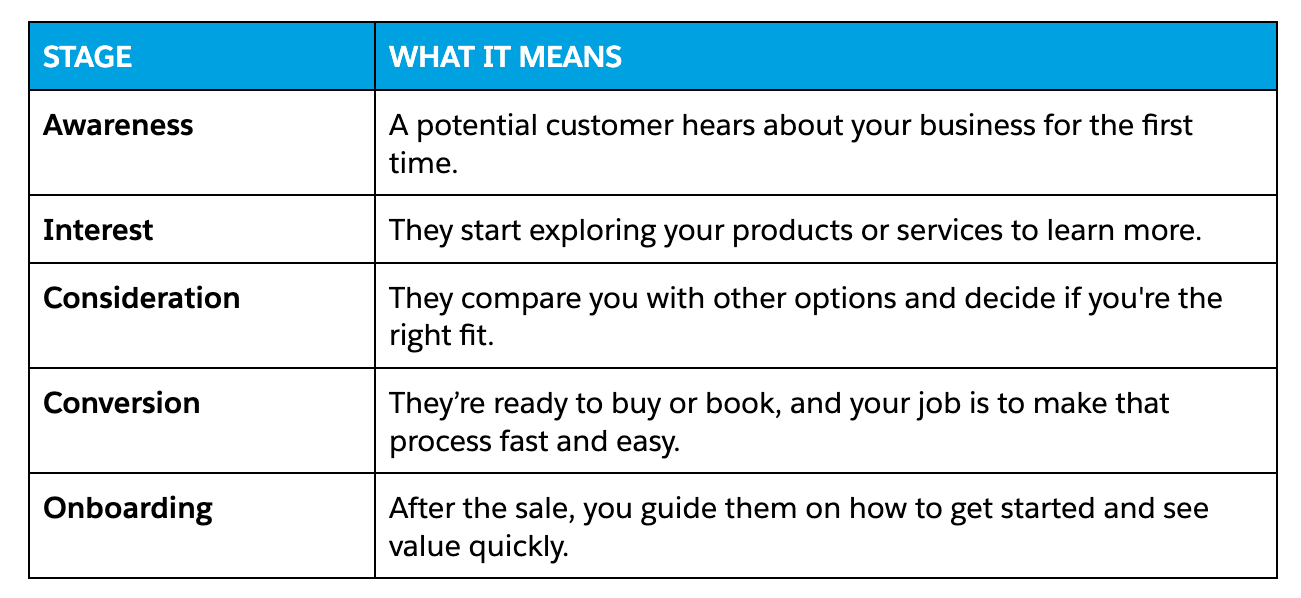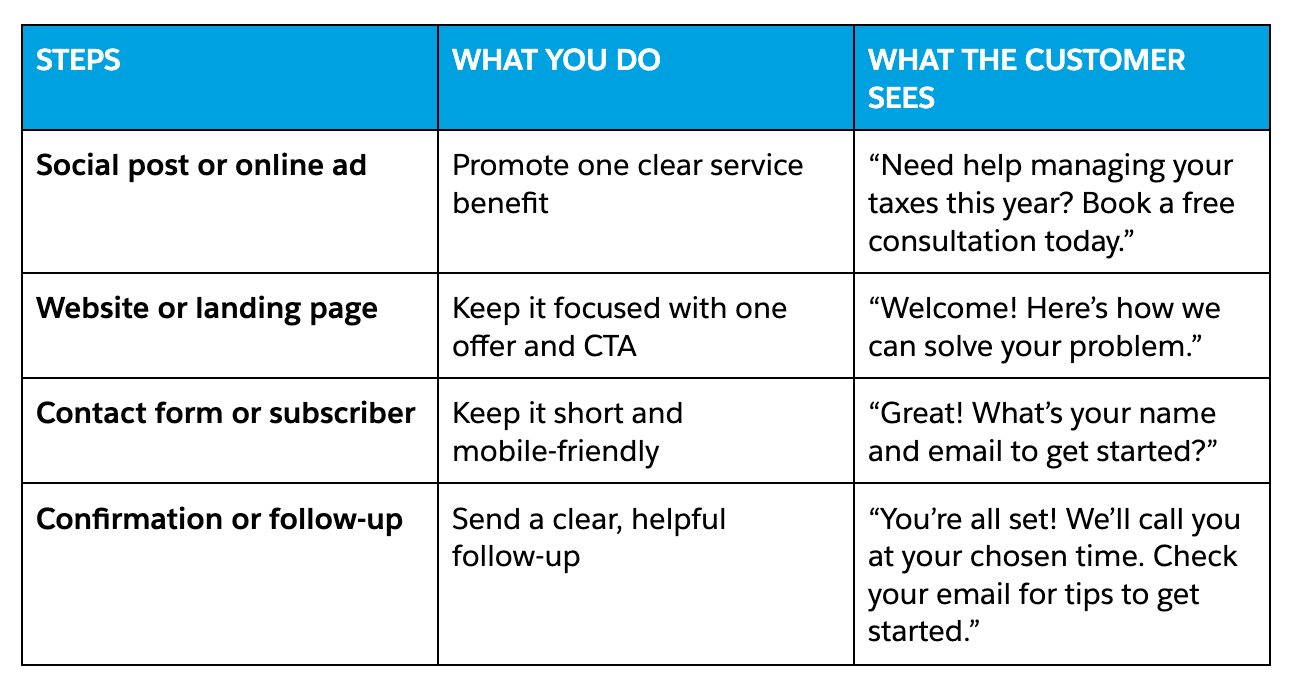You’ve built something great, and now the big question is, how do you get it in front of the right people? That’s the everyday challenge for small and medium-sized business (SMB) owners, marketers, and founders alike. It’s easy to get caught up in perfecting your product or service, but that’s only part of the equation. Without a steady flow of new customers, officially coined customer acquisition, it’s tough to grow — and even tougher to stay profitable.
If you’ve ever asked yourself how to actually get more customers, you’re in the right place. This guide will walk you through the basics of customer acquisition, from how people find you to how they decide to buy. You’ll learn what strategies work and how to build a plan that fits your goals and budget. Let’s dig in.
What is customer acquisition?
The term customer acquisition essentially means bringing new sales (customers) into your business through a refined sales strategy. It’s the process of attracting people and encouraging them to make a purchase. This could happen through different marketing channels (like online advertisements, blog posts, social media, or emails) or any other way someone first hears about your business and decides to buy from you. The goal is to grow your customer base in a steady and repeatable way.
Why is customer acquisition important for growing businesses?
It may seem obvious, but customer acquisition is how you will grow your revenue. Every new customer adds to your bottom line and helps increase sales over time. Without a steady stream of new customers, it becomes harder to grow or even maintain your current pace.
What is the purpose of customer acquisition?
Acquiring customers is how you build a strong and sustainable business. Done right, it gives your business long-term value. Here are some of the most important reasons why customer acquisition matters.
- Grow your revenue: Every new customer adds fresh income that helps you stay profitable and pay for necessities like rent, tools, salaries, and supplies.
- Build your brand: The more people who interact with your business, the stronger your brand becomes in the market.
- Create customer loyalty: Each new customer is a chance to turn a one-time buyer into a repeat customer.
- Expand your market: Bringing in new types of customers helps you test and grow into new locations, industries, or audience segments.
- Increase market share: Winning more customers helps you stay ahead of competitors and grow your influence in your space.
What can you do with a CRM built to reach more prospects?
Automate your marketing campaigns with a CRM built to grow. It all starts with Starter Suite.

Understanding the customer acquisition funnel
The customer acquisition funnel is the path prospects take from first learning about your business to becoming a paying customer. The funnel is divided into five stages: awareness, interest, consideration, conversion, and onboarding. It helps you understand what your prospects need at each step, so you can meet them where they are and guide them forward. Here’s a quick look at the main stages:
Stage 1: Awareness
What it is: This is when people learn about your business’ existence for the first time.. They might come across your digital storefront in a search, see a post on social media, or hear about you from someone they know.
What you do: At this point, they don’t know much about you, so your goal is to introduce your brand in a way that grabs attention. Think of it as making a solid first impression with your brand, website, and content.
Stage 2: Interest
What it is: The interest stage is where prospects begin exploring your products or services that you offer. They might read your blog or browse your product pages. Your goal is to keep them engaged and curious, and also move along in the marketing campaign.
What you do: Your job here is to give them useful, easy-to-understand information that explains what you do and why it matters.
Stage 3: Consideration
What it is: At the consideration stage, they’re deciding if your business is the right fit for their needs. Potential customers may compare you with competitors, read reviews, or review pricing options. This is a good time to answer common questions and provide customer testimonials.
What you do: You should try to show how you can solve their specific problems, while not pushing for the sale. This is done by building trust in your marketing and sales processes, and moving them into the conversion stage.
Stage 4: Conversion
What it is: The conversion stage is where interest turns into action. The lead is hot, and is ready to make a purchase or book a service. Your job is to make the process smooth, simple, and clear.
What you do: That means simple checkout steps, clear calls to action (CTA), and fast support powered by artificial intelligence (AI) if they need help. A customer relationship management (CRM) platform can track hot leads and send automatic follow-ups so you don’t miss out. Remove friction with multiple payment options and an AI agent that can help 24/7.
Stage 5: Onboarding
What it is: Congrats! You got the sale. Now on to onboarding or welcoming the new customer with all the information they need to be successful (or keep coming back).
What you do: Onboarding is the stage where you help customers get started and find value in what they just bought. A CRM can send personalized welcome emails or reminders to check in. Even a quick tutorial can make a big difference in the customer’s experience.
Customer acquisition funnel cheatsheet

Key customer acquisition channels you should know
Customer acquisition gets easier when you know where your potential customers spend their time. The best prospects for your business will depend on your goals, industry, and target audience. Here are a few common and effective ways you can attract new customers.
Website optimization
Search engine optimization (SEO) refers to the process of optimizing your website so that it appears higher in search engine results pages (SERPs) like Google.. This can be achieved by creating high-quality content, building backlinks, and making your website more accessible. It’s not instant, but over time, SEO builds steady, high-quality traffic to your website without having to pay for every click.
Ideal if: You want steady, low-cost traffic over time. SEO takes effort, but it pays off. Keep your blogs, landing pages, and product pages fresh each week with helpful updates and relevant keywords your customers are actually searching for.
Content marketing
Content marketing involves creating and distributing helpful blogs, articles, videos, infographics, and other forms of content consistently. Content marketing builds trust by showing that your business understands your customers’ needs. Work closely with an SEO team and build a strong foundation for acquisition strategies just by telling your story.
Ideal if: If you want to build credibility and attract people through free, helpful information rather than direct paid promotions. It works best with a consistent schedule. Aim to publish blogs or content pieces weekly to keep momentum and stay visible.
Social media marketing
Social media marketing involves using social platforms such as Facebook, X, Instagram, and LinkedIn to connect with potential customers and build relationships with partners. It is one of the easiest ways to get new customers in the door without sounding salesy. Just show up as yourself. Share real photos or videos of your product, happy customers, or even your team at work. Tag local creators or influencers who might love what you’re offering. You can also run fun giveaways or special offers to get people excited.
Ideal if: Your audience spends time on social platforms and you want to grow brand awareness and community engagement. It’s something you need to do daily. You have to share content that sparks interest and keeps your brand top of mind.
Email marketing
Email marketing lets you connect directly with people who have shown interest in your business. It involves sending promotional emails to a list of subscribers. This can be an effective way to stay in touch with prospects and customers, promote new products or services, and build traffic to your online store. Email marketing tools also let you segment your audience and send personalized messages based on behavior.
When to use it: If you’re collecting leads and want to stay in touch in a personal, cost-effective way. A good rule of thumb? You can mix it up. Send newsletters monthly, nurture emails weekly, and timely updates as needed.
Referral marketing
People trust recommendations from people they know. Referral marketing encourages your current customers to spread the word by offering them an incentive (like a discount or gift) for every new person they bring in. It’s a simple and often low-cost way to grow your customer base through trust.
Ideal if: You have happy customers who’d likely recommend your product or service to others. It works best right after a positive purchase experience, like when they leave a review or become a repeat customer.
Influencer or partner marketing
Working with influencers or content creators allows you to reach new audiences through someone they already trust. This could include social media collaborations, guest content, joint webinars, or co-branded campaigns. The key is choosing partners who align with your brand and share similar values.
Ideal if: You’re looking to expand your reach quickly and tap into established audiences in your niche or industry. It works best when timed around product launches, campaigns, or moments when visibility matters most.
Paid advertising
Paid ads give you the ability to reach specific groups of people based on things like location, interests, and behavior. This includes Google Ads, Facebook and Instagram ads, YouTube pre-roll ads, and more. It’s a quick way to generate visibility and traffic. However, it requires careful planning and tracking to make sure your ad spend is turning into actual results and you’re getting a positive return on investment (ROI).
Ideal if: You want to get fast results, promote a specific offer, or reach a targeted audience on a defined budget. Best used during time-sensitive campaigns, seasonal pushes, or when you need quick visibility.
Join millions in the growing Salesforce ecosystem
Trailblazers are free to reinvent themselves, free to dream bigger.

How to measure customer acquisition effectively
Measuring your customer acquisition efforts is just as important as running them. Keeping a close eye on these metrics helps you make informed decisions and get the most value from your time and budget. Here are the key metrics you should track to understand and improve your customer acquisition performance.
1. Customer acquisition cost (CAC)
Customer acquisition cost (CAC) is the total cost of acquiring one new customer. It includes money spent on marketing, sales, tools, and any related resources. It tells you how efficient your acquisition efforts are. If CAC is too high, you may be spending more to get customers than they’re actually worth to your business.
Formula: CAC = Total acquisition cost ÷ Number of new customers acquired
For example, if you spent $5,000 in one month on marketing and sales and gained 100 new customers, your CAC would be $50.
2. Conversion rate
Conversion rate measures the percentage of people who take a desired action like signing up or booking a call after visiting your site or campaign. A higher conversion rate means more of your leads are turning into customers. It shows how well your messaging, landing pages, and offers are working.
Formula: Conversion rate = (Conversions ÷ Total visitors or leads) × 100
For example, if 1,000 people visit your landing page and 50 make a purchase, your conversion rate is 5%.
3. Customer lifetime value (CLV or CLTV)
Customer lifetime value (CLV) is the total revenue you expect to earn from a single customer over the entire time they do business with you. It helps you understand how much a customer is worth to your business. When you compare this to CAC, you get a better picture of your return on investment.
Formula: CLV = Average purchase value × Purchase frequency × Average customer lifespan
For example, if a customer spends $100 per month, buys 12 times a year, and stays for 3 years, their CLV is $3,600.
4. Payback period
Payback period is the time taken to earn back what you spent to acquire a customer. Shorter payback periods mean faster returns. This is especially important for small businesses that rely on cash flow.
Formula: Payback period = CAC ÷ Average monthly profit per customer
For example, if your CAC is $200 and you make $50 profit per customer each month, your payback period is 4 months.
5. Lead-to-customer rate
The lead-to-customer rate (LCR) is the percentage of prospects that become paying customers. It helps you understand the quality of your leads and how well your sales process is working.
Formula: Lead-to-customer rate = (Number of customers ÷ Number of leads) × 100
For example, if you had 200 leads and 40 became customers, your rate would be 20%.
6. Channel ROI
This is the return on investment (ROI) for each marketing or sales channel you use. It measures how much value you get compared to what you spend on that channel. That way, you can double down on what works and cut back on what doesn’t.
Formula: ROI = (Revenue from channel − Cost of channel) ÷ Cost of channel × 100
For example, if a Facebook campaign brings in $3,000 and costs $1,000, the ROI is 200%.
Learn 7 ways reps can use AI to speed up sales
See real-life examples of using AI to sell, from automating prospecting to writing emails and getting real-time guidance.


How to reduce your customer acquisition cost
Lowering your customer acquisition costs means getting more value from every dollar you spend. One of the best ways to reduce CAC is by using a CRM tool. A CRM helps you manage leads and customer details in one place. It keeps track of how people find you and where they’re in the buying process.
Here are some ways to bring CAC down and make your acquisition efforts more efficient.
- Focus on the right audience: Use CRM insights to target high-performing segments and cut spend on low-performing channels.
- Improve conversion rate: Optimize landing pages and CTAs to get more results without raising your budget.
- Use organic channels: Invest in SEO, content, and social media, and use your CRM to track what brings in leads.
- Retarget warm leads: Reengage site visitors or past engagers with retargeting ads or email journeys using CRM data.
- Build referral programs: Encourage and track customer referrals through your CRM to grow through word of mouth.
Wherever you are — just get started.
No matter where you are on your journey as a business owner, you can get started with Starter Suite for free — the CRM made for growth.

How to build a strong customer acquisition strategy
A strong customer acquisition strategy helps you reach the right people and convert them into paying customers. Having a clear plan in place saves time and makes sure that every effort you make has a clear goal. Here’s how to build a strategy that works for your business:
1. Define your ideal customer
The first step in any strong acquisition strategy is knowing who you’re trying to reach. Spend time defining your ideal customer profile. Think about who needs your product or service and what problems they’re facing. Understanding your customer helps you make better choices like what kind of content to create or how to talk about your product in a way that resonates.
2. Set clear and measurable goals
Once you know who you’re trying to reach, the next step is figuring out what you want your strategy to accomplish. Do you want more people visiting your website? Are you trying to grow your email list? Do you need more booked demos or online purchases? Setting specific and measurable goals helps you stay focused and gives you something to track against.
3. Choose your acquisition channels wisely
You have to choose the channels where your audience already spends time and where your message will be most effective. For small businesses, organic search and blog content are great long-term bets. Others might see quicker results from paid advertising or referral programs. Your channels should align with your audience, your goals, and your budget. You can start with one or two channels. Then track how they perform and build from there.
4. Develop a strong value proposition
Your value proposition should answer this question: Why should someone choose your business over others? You’ll use this message across your content, ads, emails, and sales materials, so make sure it’s clear and easy to understand. It should highlight:
- The specific problem you solve
- The benefit your product or service provides
- What makes you different or better than your competitors
5. Build a clear path to conversion
A strong acquisition strategy includes a clear and simple path that guides people from interest to action. This path should remove as much friction as possible. If you’re sending them to a product page, make sure it answers key questions and explains why it’s worth buying. If you’re asking someone to fill out a form, make sure it’s short and mobile-friendly. The goal is to make it easy for people to say yes.
Example: A simple, low-friction path to win new customers:

6. Nurture leads who aren’t ready yet
Not everyone who finds you will be ready to buy right away, and that’s completely normal. You have to build trust with them through relevant content and follow-up emails. The goal is to give them reasons to come back when the time is right for them. Here are a few ways to nurture leads:
- Set up automated email sequences with relevant, customized content
- Share inspiring case studies or customer testimonials to build value
- Offer swag, product demos or free trials
- Follow up with personalized messages, brought to you by your CRM
Tools and technology that support customer acquisition
Customer acquisition involves many moving parts — capturing, nurturing, tracking, and closing leads. A CRM for SMB stores all your prospect and customer information in one place. It shows you every touchpoint with that full picture, so it’s much easier to move leads closer to the sale.
If you run a small business, a CRM like Starter Suite can help you grow without making things more complicated. If you’re ready for more advanced tools, Pro Suite is designed for growing small businesses that need customized features as they grow. Whether you’re just starting out or trying to scale, Salesforce gives you the tools to do it right.
Now, AI is making this even more powerful. With the help of built-in intelligence, your CRM can suggest the best times to follow up or highlight which leads are most likely to convert. This helps you prioritize leads and connect better with them without doing everything manually.
AI agents take this a step further by not just offering suggestions, but acting on them. They can send follow-ups, answer routine questions, and move leads through the sales funnel — all on their own. At Salesforce, these AI agents come to life through Agentforce. If you want to get started with AI, you can activate Foundations on your existing CRM today.
Grow Your Small Business With AI Agents
Learn how autonomous artificial intelligence (AI) can scale your small business for efficient growth with this free e-book.

Thank you for downloading the free e-book "Grow Your Small Business With AI Agents"
Here's your free e-book!Turning customer acquisition into long-term growth
Getting new customers is key to growth, but real progress comes from having a system that attracts the right people consistently. When you understand your audience and track what’s working, customer acquisition becomes more predictable. A CRM can help by keeping your leads organized and making follow-ups easier. If you’re just starting out or need a simple way to manage sales, support, marketing, or your online store, Salesforce offers tools designed to keep everything in one place.
So, why not start strong? Kickstart your journey with Starter Suite. Looking for more customization? Explore Pro Suite. Already a Salesforce customer? Activate Foundations and try out Agentforce 360 today.
AI supported the writers and editors of this article.
Want to take the #1 CRM for a test drive?
Go on our Guided Tour to see how Sales Cloud boosts productivity at every stage of the sales cycle.





























